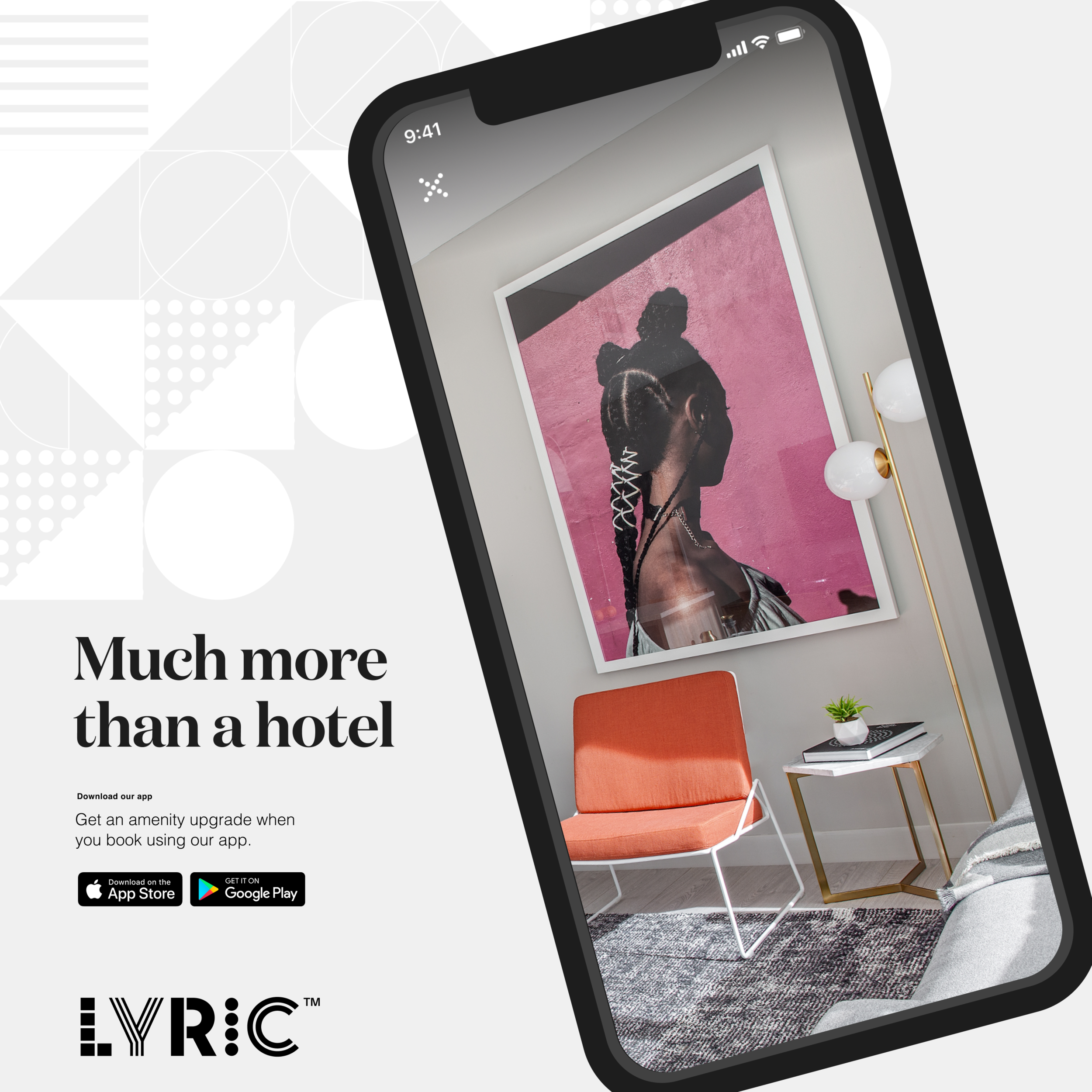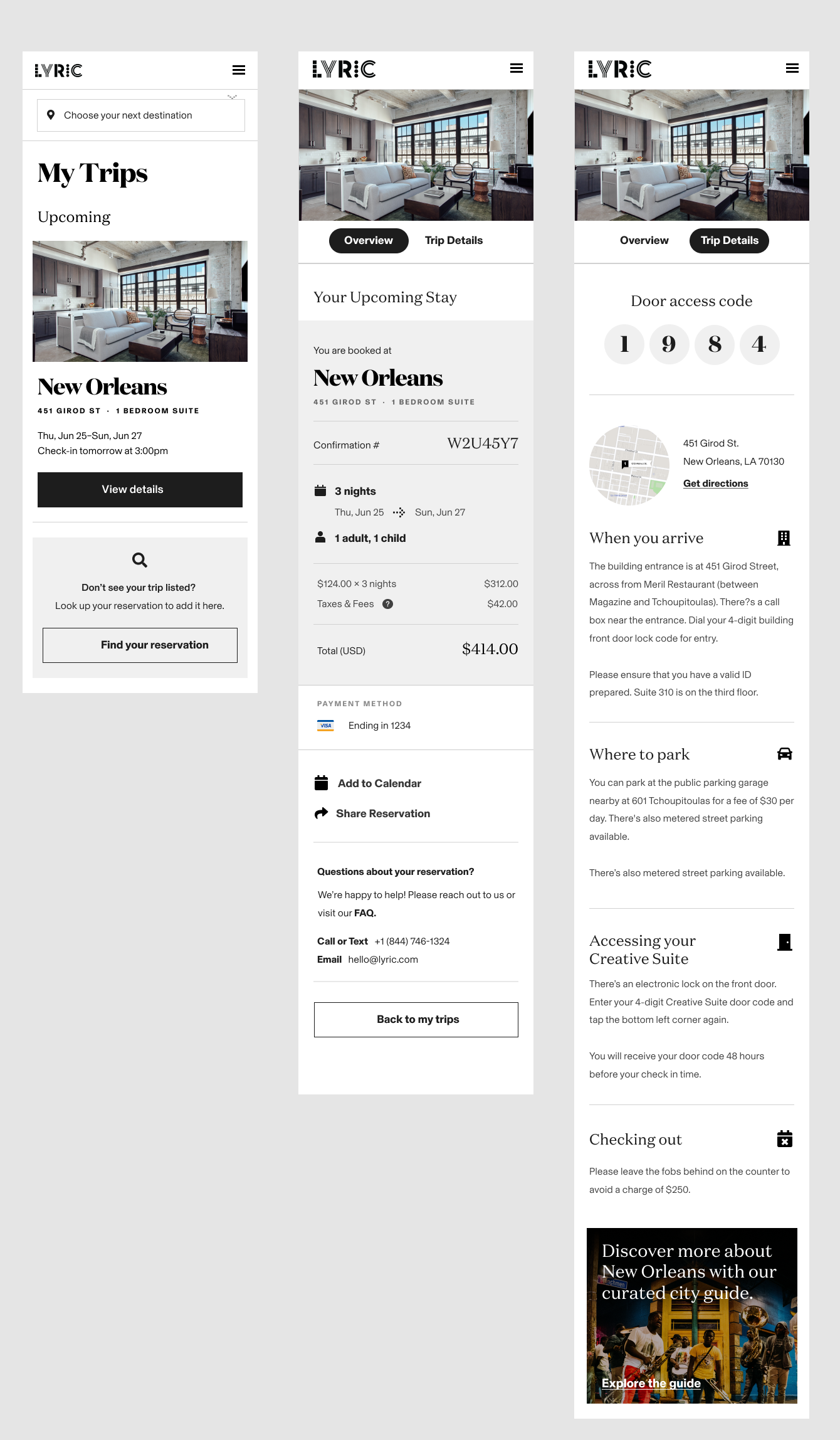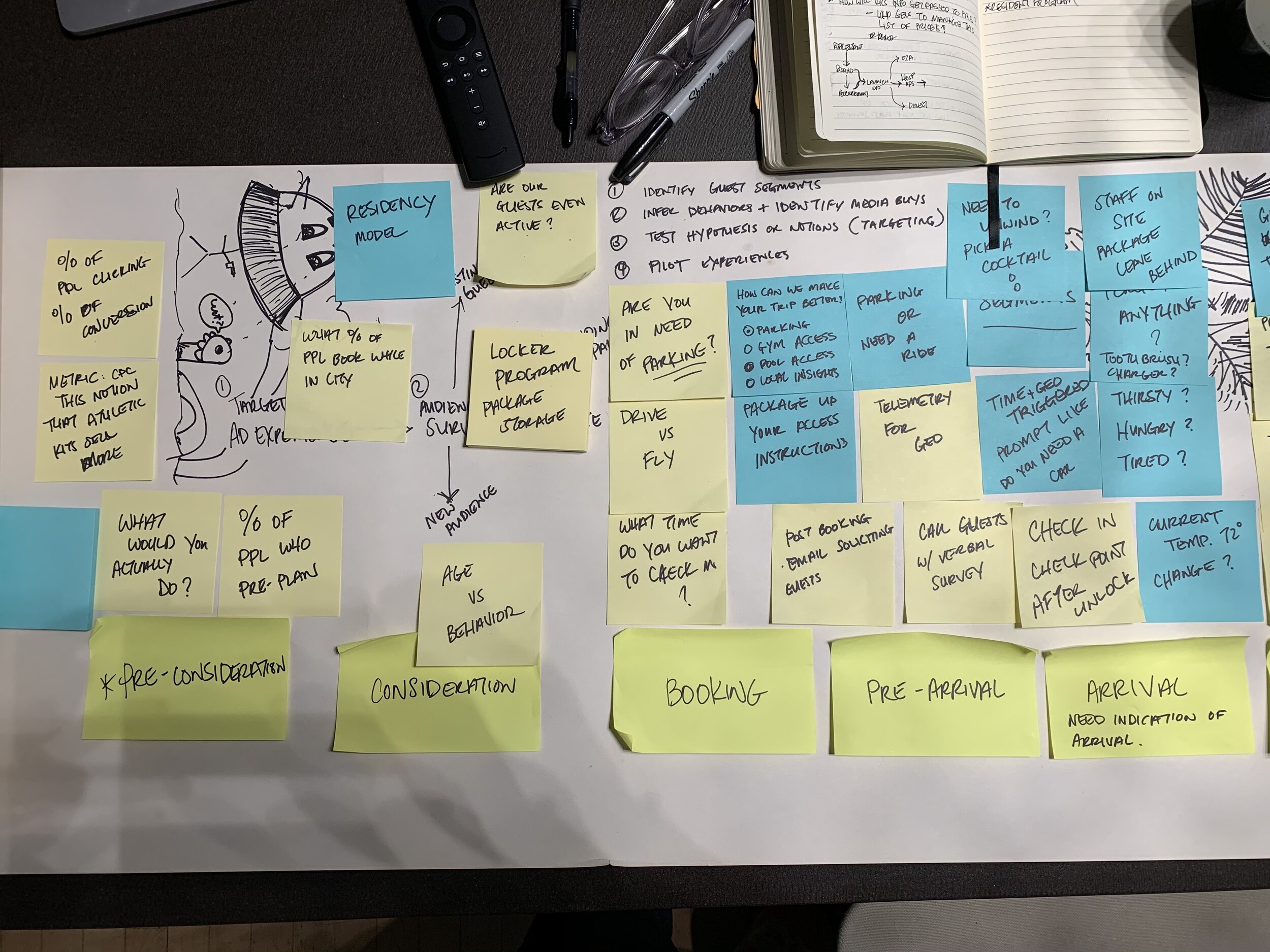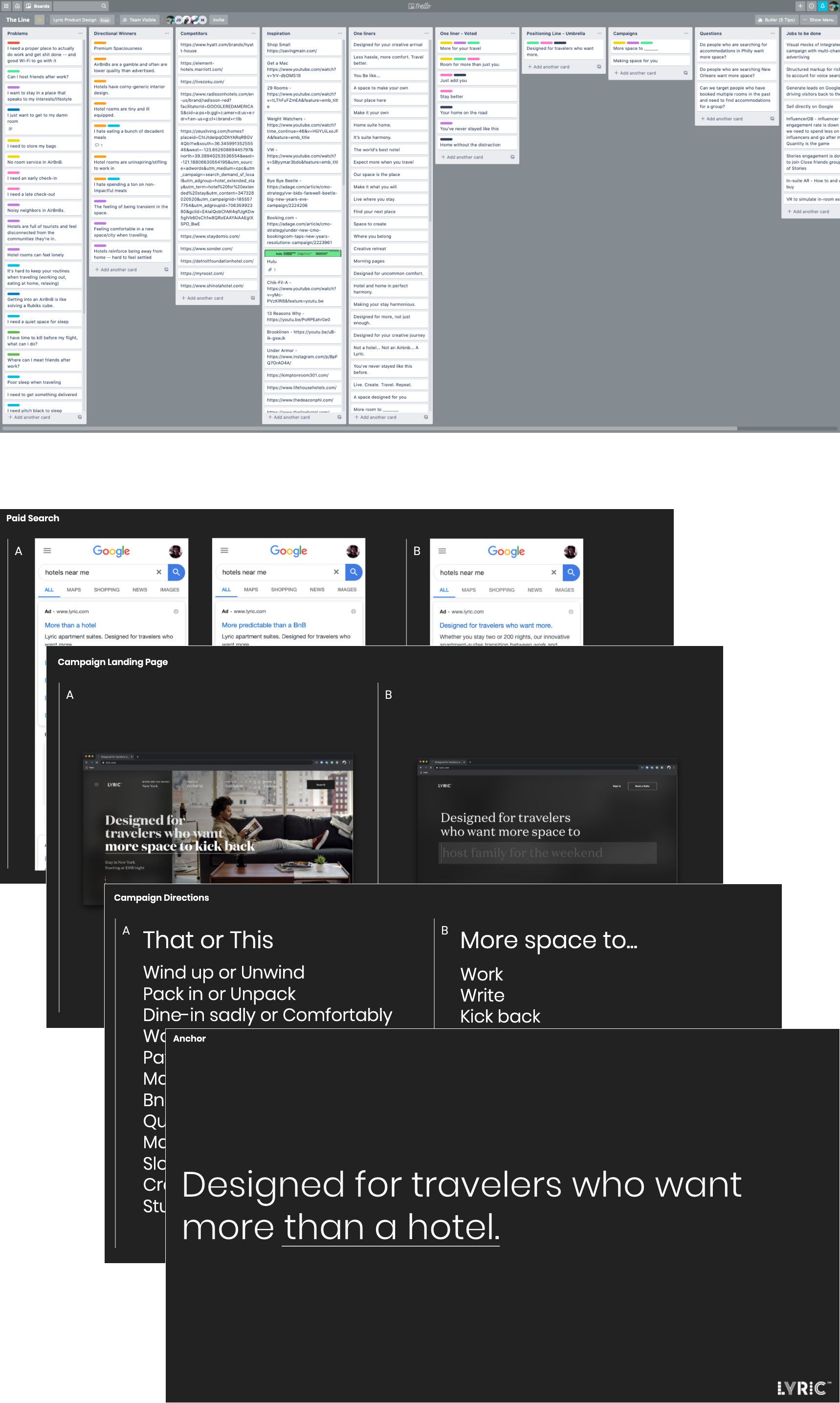Elevated Short Term Rentals
Lyric offers managed apartments that can be booked directly or on platforms like Airbnb, Kayak, Expedia, and Booking.com. This new category of accommodations in the hospitality space emerged out of AirBnB’s demand for quality listings that featured hotel amenities with the comforts of home in major metropolitan areas. Through acquiring remnant inventory from developers of premium apartments, Lyric can offer highly localized experiences that hotels can not provide to their guests unless they overhaul their floorplates to include full kitchens and living and dining rooms. I was brought on to head product design and had the opportunity to guide a multidisciplinary team in delivering experiences to the market.
Mobile App Features
Booking
Retrieving reservations
Explore amenities
Instructions
Directions
Nearby
Guests profile
Change reservation
Unlock building
Unlock room
Process of arrival
Understanding the guest journey
We conducted surveys, interviews, and field studies to capture quotes, sentiment, offline and online activities, and deltas. This stage was a critical onboarding exercise to align the guest needs as we began conceptualizing the pipes for the ecosystem. Throughout this process, stakeholders from different disciplines were brought in to add insights and any direct consumer feedback. No stones were left unturned. We needed all the data points.
Finding emergent patterns
After the qualitative research phase, we kicked off the generative ideation phase. Combining techniques like mock press releases, crazy 8s, and other methods of teasing out ideas, I held workshops with key stakeholders to help us ideate. Beyond concepts, this process was just as much of a team-building exercise. Allowing everyone to share their insights and participate in a creative-led session provided a great outlet and environment for connecting. It’s one thing to work together in an office, but when you can ideate together, it makes work more fun.
Vetting, Prototyping, and Testing
After the collaborative workshops, we themed and ranked each idea based on criteria that simultaneously met the business and guest needs. Then we prototyped and conducted acceptance testing to validate the direction further. All of this takes place within a week. After we run a round of acceptance testing, we determine whether we move forward or go back to the generative ideation phase to arrive at another proof of concept to test. While this process could take several rounds, the intention is to vet the pictures to see what sticks thoroughly.
The Agent Experience
I started working with guest services and support agents as they were the first responders in the ecosystem and had direct contact with guests. While it was a relatively small dataset, what I was able to ascertain from working with agents, was a variety of conditions that resulted in poor experiences that agents could remedy and then convert into positive engagements that led to repeat bookings. I sought to understand the nuances, model and improve the interactions, and design a scalable system that enabled agents to work with less friction. As this was a new category and the tools of the trade were generally not integrated well, agents had to utilize many tools and service layers to generate a complete picture of a guest. While there are several property management tools on the market, they are overwhelmingly expensive and inflexible. Small operators are beholden to a third party’s feature release cycles, and only the ones with the deepest pockets can influence the features. The CEO wanted to innovate in this area and maintain the integrity of our datasets, so we designed and developed a category-specific application that stitched together the best-in-class functional experiences into a unified dashboard for agents to serve guests better. The key features of this experience included; a unified view of the guest history, the ability to read and write reservations, make modifications, send quotes, manage marketing, and capture exchanges and tickets in a single tool. This building block was an essential piece of the bigger vision, as it dovetailed into a dynamic pricing engine for scouting property, thus generating an active real estate feedback loop.
The Guest Experience
The guest experience was the sum of all parts - a highly cross-functional initiative. The effort resulted in the launch of a refreshed and mobile-optimized brand website, community blog, new booking experience, mobile app, and improved third-party merchandising.











The Mobile App
We had many iterations and deliberated on whether we wanted to gate the experience or make it retrieve reservations. After much debate, we opted to gate the experience for added security despite the barrier of entry.
V1 - Focused on building the user profile.
V1.1 - Featured access to reservations and support
V2 - Slated to have contactless entry, mobile booking, and modify a reservation
The longer-term vision of the app was to provide guests with access to the communities they were visiting by leveraging local relationships. We wanted to support small businesses and give visitors authentic experiences rooted in the local cultures.
The Booking Experience
The legacy site was one giant react native app requiring engineers to update content. The performance was poor, and the place wasn’t optimized for mobile. While this may have been manageable for a small company, the company exceeded 20 properties and over 150 employees. Like most tech companies, we didn’t have enough resources to execute at the rate that the company had planned in its trajectory. The site was no longer tenable nor relevant and cost more money to maintain than the revenue it was generating on average. We needed better systems to manage both resources and products. It was time for a brand refresh that unified the culture, optimized the experience, and defined a new category.
During the inquiry phase of this initiative, we had many stakeholders concerned about a redesign effort. Historically, at Lyric, product, engineering, and design were functions that rarely overlapped. The interior and brand designers considered themselves the only product designers and excluded digital touchpoints as a necessary experience in the product and service ecosystem. I worked with leadership to change the culture - neutralize ownership to improve cross-functional collaboration, and concurrently worked with development, data science, and engineers to deliver;
1. a headless CMS that unified an aggregate of property and geographic information
2. a process that decoupled content management from engineering tasks
3. a process for content managers to read, write and edit content
4. a system that enabled booking and brand to operate independently while maintaining a unified end-user experience
5. a method for data science to harvest quantitative data
The Brand Campaign
After the foundational and functional pieces of the ecosystem were instantiated, it was campaign time. We needed the brand value prop, what it stood for and how it differentiated from other companies in the short-term rental space. The company had been using a tagline of “Unlock Possible” and, over time, recognized that it didn’t resonate with the marketplace. We had a hunch that it was vague, too open-ended, and failed to describe the new inventory category. We confirmed the suspicion through focus groups and surveying repeat guests. In reflecting on creating a culture of radical transparency, we wanted the brand to exhibit one of our core values - inclusion. Inclusion does not obscure or codify language that only a tiny segment of the population would understand; we wanted everyone to get it without the pedantic subtext. After leading several internal work sessions to arrive at a campaign strategy, we reached a consensus on communicating through comparison and netted out with a simple statement of “more than a hotel” to solicit discovery.
The new creative direction elevated the category in a way that competed directly with hotels; there was no question about it. In our new tagline(s), we wanted to communicate our value proposition clearly, and through multivariate testing taglines in search ads, we saw an initial 30% lift in adoption. We took a bold stance to compete in a marketplace where we had an opportunity to challenge traditional accommodations and gain an audience that was previously unaware of this category. This was a radical departure from the approach of only appealing to a design-driven muse. We cast a broader net to appeal to everyone who aspires to combine work with personal travel and instantiated the new category. Here’s the complete executive presentation of the integrated campaign proposal.
I am coming up with a new tagline.
Half of the team was remote, and while we traveled extensively to join the people at HQ, we also wanted to capture our process in a shared environment not limited to geography. Using Trello, I could capture notes and turn them into cards that we could sort into buckets. Trello is a great visual tool for card sorting and tracking progression. I tried using other tools like Lucid Charts, Figma, Google Slides, Jira, and Slack. Trello was the clear winner.
Channel Merchandising
87% of all reservations were from third-party booking channels. However, we weren’t satisfied with how channels classified this new inventory category and needed to optimize the experience to communicate how it differed from hotels and BnBs. What started as a highly collaborative effort between Lyric and Kayak to define the category became a regimen of multivariate testing across several dimensions that helped us formulate hypotheses around the overall performance of the new inventory against traditional hotels. Kayak and a few other channels were betting on this new category to create a sea change in demand that could ultimately equalize the playing field and give independent operators a chance to compete in the marketplace. An example of the audit that was conducted and ideas shared with a booking channel can be viewed here.










